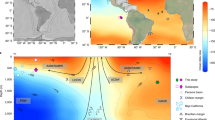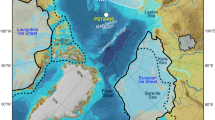Abstract
Antarctic Intermediate Water is, at present, a water mass that brings oxygen to intermediate depths throughout the Southern Hemisphere oceans. Models have suggested that intermediate waters had higher concentrations of oxygen during the last glacial period1,2, consistent with globally reduced denitrification3 and increased production of Antarctic Intermediate Water4. However, some palaeoceanographic reconstructions5,6 have indicated that production decreased in the southeast Pacific Ocean at this time. Here we analyse the concentrations of Re and Mn, the sedimentary concentrations of which are controlled by the amount of dissolved oxygen at the sea floor, from three sediment cores located along the Chilean margin for the past 30,000 years. Our results from the cores, which bracket the present-day water-column extent of Antarctic Intermediate Water, show that the depth range of well-oxygenated Antarctic Intermediate Water increased off Chile during the Last Glacial Maximum. Dissolved oxygen content began to decrease approximately 17,000 years ago, coincident with rapid Antarctic warming and a poleward shift of the southern westerly winds7. Our estimates of productivity from accumulation rates of organic carbon and opal do not co-vary with the seafloor oxygen variations, ruling out local control of seafloor oxygenation. We conclude that the data are best explained by a combination of increased oxygenation and increased flux of Antarctic Intermediate Water during the Last Glacial Maximum.
This is a preview of subscription content, access via your institution
Access options
Subscribe to this journal
Receive 12 print issues and online access
$259.00 per year
only $21.58 per issue
Buy this article
- Purchase on Springer Link
- Instant access to full article PDF
Prices may be subject to local taxes which are calculated during checkout



Similar content being viewed by others
References
Meissner, K. J., Galbraith, E. D. & Völker, C. Denitrification under glacial and interglacial conditions: A physical approach. Paleoceanography 20, PA3001 (2005).
Liu, Z. et al. Tropical cooling at the last glacial maximum and extratropical ocean ventilation. Geophys. Res. Lett. 29, 1409 (2002).
Galbraith, E. D., Kienast, M., Pedersen, T. F. & Calvert, S. E. Glacial–interglacial modulation of the marine nitrogen cycle by high-latitude O2 supply to the global thermocline. Paleoceanography 19, PA4007 (2004).
Lynch-Stieglitz, J. & Fairbanks, R. G. Glacial–interglacial history of Antarctic Intermediate Water: Relative strengths of Antarctic versus Indian Ocean sources. Paleoceanography 9, 7–29 (1994).
Bostock, H. C., Opdyke, B. N., Gagan, M. K. & Fifield, L. K. Carbon isotope evidence for changes in Antarctic Intermediate Water circulation and ocean ventilation in the Southwest Pacific during the last deglaciation. Paleoceanography 19, PA4013 (2004).
Pahnke, K. & Zahn, R. Southern Hemisphere water mass conversion linked with North Atlantic climate variability. Science 307, 1741–1746 (2005).
Anderson, R. F. et al. Wind-driven upwelling in the Southern Ocean and the deglacial rise in atmospheric CO2 . Science 323, 1443–1448 (2009).
Sloyan, B. M. & Rintoul, S. R. Circulation, renewal, and modification of Antarctic mode and intermediate water. J. Phys. Oceanogr. 31, 1005–1030 (2001).
Strub, P. T., Mesı´as, J. M., Montecino, V., Rutllant, J. & Salinas, S. in The Sea Vol. 11 (eds Robinson, A. R. & Brink, K. H.) Ch. 10, 273–313 (John Wiley, 1998).
Mix, A. C., Tiedemann, R. & Blum, P. in Proc. ODP, Init. Repts. Vol. 202 (eds Mix, A. C., Tiedemann, R. & Blum, P.) 1–145 (Ocean Drilling Program, 2003).
Crusius, J., Calvert, S. E., Pedersen, T. F. & Sage, D. Rhenium and molybdenum enrichments in sediments as indicators of oxic, suboxic, and sulfidic conditions of deposition. Earth Planet. Sci. Lett. 145, 65–78 (1996).
Nameroff, T. J., Balistrieri, L. S. & Murray, J. W. Suboxic trace metal geochemistry in the eastern tropical North Pacific. Geochim. Cosmochim. Acta 66, 1139–1158 (2002).
Lamy, F. et al. Antarctic timing of surface water changes off Chile and Patagonian ice sheet response. Science 304, 1959–1962 (2004).
Garcia, H. E., Locarnini, R. A., Boyer, T. P. & Antonov, J. I. World Ocean Atlas 2005 Vol. 3: Dissolved Oxygen, Apparent Oxygen Utilization, and Oxygen Saturation (US Government Printing Office, 2006).
Gersonde, R. et al. Last glacial sea surface temperatures and sea-ice extent in the Southern Ocean (Atlantic-Indian sector): A multiproxy approach. Paleoceanography 18, 1061 (2003).
Matsumoto, K., Lynch-Stieglitz, J. & Anderson, R. F. Similar glacial and Holocene Southern Ocean hydrography. Paleoceanography 16, 445–454 (2001).
Hebbeln, D., Marchant, M. & Wefer, G. Paleoproductivity in the Southern Peru–Chile Current through the last 33,000 yr. Mar. Geol. 186, 487–504 (2002).
Mohtadi, M. et al. Deglacial pattern of circulation and marine productivity in the upwelling region off Central-South Chile. Earth Planet. Sci. Lett. 272, 221–230 (2008).
Matear, R. J., Hirst, A. C. & McNeil, B. I. Changes in dissolved oxygen in the Southern Ocean with climate change. Geochem. Geophys. Geosyst. 1, 1050 (2000).
Plattner, G.-K., Joos, F. & Stocker, T. F. Revision of the global carbon budget due to changing air-sea oxygen fluxes. Glob. Biogeochem. Cycles 16, 1096 (2002).
Ganeshram, R. S., Pedersen, T. F., Calvert, S. E., McNeill, G. W. & Fontugne, M. R. Glacial–interglacial variability in denitrification in the world’s oceans: Causes and consequences. Paleoceanography 15, 361–376 (2000).
Schmittner, A., Oschlies, A., Matthews, H. D. & Galbraith, E. D. Future changes in climate, ocean circulation, ecosystems, and biogeochemical cycling simulated for a business-as-usual CO2 emission scenario until year 4,000 AD. Glob. Biogeochem. Cycles 22, GB1013 (2008).
Böning, P., Brumsack, H.-J., Schnetger, B. & Grunwald, M. Trace element signatures of Chilean upwelling sediments at ∼36∘ S. Mar. Geol. 259, 112–121 (2009).
DeMaster, D. J. The supply and accumulation of silica in the marine environment. Geochim. Cosmochim. Acta 45, 1715–1732 (1981).
Hedges, J. I. & Stern, J. H. Carbon and nitrogen determinations of carbonate-containing solids. Limnol. Oceanogr. 29, 657–663 (1984).
Verardo, D. J., Froelich, P. N. & McIntyre, A. Determination of organic-carbon and nitrogen in marine sediments using the Carlo Erba Na-1500 Analyser. Deep-Sea Res. I 37, 157–165 (1990).
Kaiser, J., Lamy, F. & Hebbeln, D. A 70-kyr sea surface temperature record off southern Chile (Ocean Drilling Program Site 1233). Paleoceanography 20, PA4009 (2005).
Fairbanks, R. G. et al. Marine radiocarbon calibration curve spanning 0 to 50,000 yr B.P. based on paired 230Th/234U/238U and 14C dates on pristine corals. Quat. Sci. Rev. 24, 1781–1796 (2005).
Toggweiler, J. R., Dixon, K. & Bryan, K. Simulations of radiocarbon in a course-resolution world ocean model 1. Steady state prebomb distributions. J. Geophys. Res. 94, 8217–8242 (1989).
EPICA community members. One-to-one coupling of glacial climate variability in Greenland and Antarctica, Nature 444, 195–198 (2006).
Acknowledgements
B. Gentry, T. Schell, A. Ungerer and J. Jennings all assisted in the laboratory. Samples used in this work were provided by the Ocean Drilling Program. This research was financially supported by the National Science Foundation (OCE-0526278 and OCE-0753487). Extra financial support was provided by the Gordon & Betty Moore Foundation. Any opinion, finding, and conclusions or recommendations expressed in this material are those of the authors and do not necessarily reflect the views of the National Science Foundation.
Author information
Authors and Affiliations
Contributions
All authors contributed extensively to this work. J.M.M. prepared the manuscript and gathered the metals data. J.M. and Z.C. provided the opal data and half of the organic carbon data. A.C.M. provided 14C data for Sites 1234 and 1235.
Corresponding author
Ethics declarations
Competing interests
The authors declare no competing financial interests.
Supplementary information
Supplementary Information
Supplementary Information (PDF 309 kb)
Rights and permissions
About this article
Cite this article
Muratli, J., Chase, Z., Mix, A. et al. Increased glacial-age ventilation of the Chilean margin by Antarctic Intermediate Water. Nature Geosci 3, 23–26 (2010). https://doi.org/10.1038/ngeo715
Received:
Accepted:
Published:
Issue Date:
DOI: https://doi.org/10.1038/ngeo715
This article is cited by
-
Solenosmilia variabilis-bearing cold-water coral mounds off Brazil
Coral Reefs (2020)
-
Enhanced ocean-atmosphere carbon partitioning via the carbonate counter pump during the last deglacial
Nature Communications (2018)
-
The impact of ocean deoxygenation on iron release from continental margin sediments
Nature Geoscience (2014)
-
Nutricline shoaling in the eastern Pacific warm pool during the last two glacial maxima
Journal of Oceanography (2014)
-
The acceleration of oceanic denitrification during deglacial warming
Nature Geoscience (2013)



